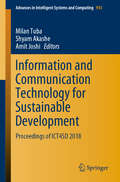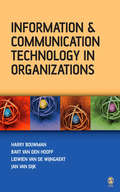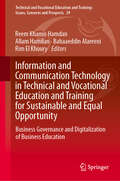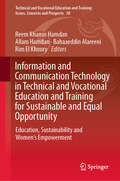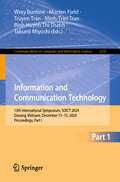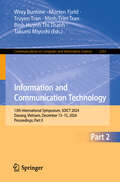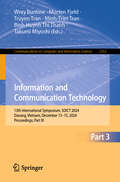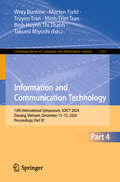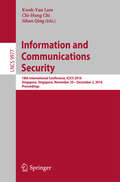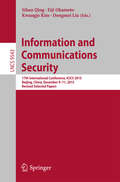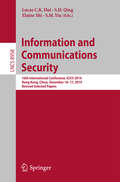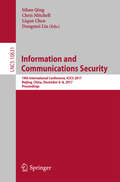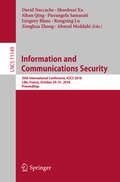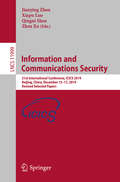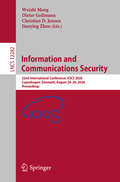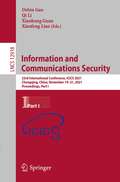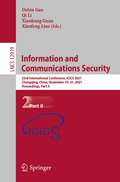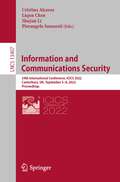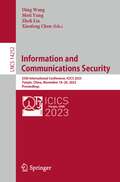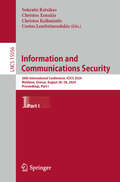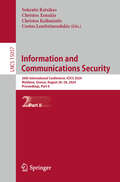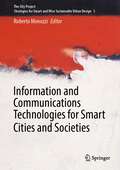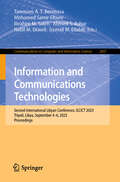- Table View
- List View
Information and Communication Technology for Sustainable Development: Proceedings of ICT4SD 2018 (Advances in Intelligent Systems and Computing #933)
by Amit Joshi Shyam Akashe Milan TubaThe book proposes new technologies and discusses future solutions for ICT design infrastructures, and includes high-quality submissions presented at the Third International Conference on ICT for Sustainable Development (ICT4SD 2018), held in Goa, India on 30–31 August 2018. The conference stimulated cutting-edge research discussions among pioneering researchers, scientists, industrial engineers, and students from all around the world. Bringing together experts from different countries, the book focuses on innovative issues at an international level.
Information and Communication Technology in Organizations: Adoption, Implementation, Use and Effects
by Harry Bouwman Jan A van Dijk Bart van den Hooff Lidwien van de WijngaertHow best can we understand why the application of information and communication technology in organizations succeeds or fails? Calling on technical, organisational, social, psychological and economic perspectives, this book provides a fresh and comprehensive framework for answering this question. Consideration is given to how ICT is adopted, implemented and used within organizations. Throughout special features will help readers clarify their understanding. These features include: - Case studies and vignettes that chart the opportunities and pitfalls created by ICT - Useful chapter introductions - An up to date glossary of concepts and abbreviations
Information and Communication Technology in Technical and Vocational Education and Training for Sustainable and Equal Opportunity: Business Governance and Digitalization of Business Education (Technical and Vocational Education and Training: Issues, Concerns and Prospects #39)
by Allam Hamdan Bahaaeddin Alareeni Reem Khamis Hamdan Rim El KhouryThis book provides an in-depth analysis of current development concerning ICTs with reference to vocational education and training. It presents the best and innovative ICT-based solutions implemented in education and explores controversial topics such as challenges and opportunities. Information and communication technologies (ICTs) have dramatically changed the way we learn and work. They have created new opportunities along with new challenges, putting profound and urgent implications on vocational education and training (VET). Nowadays, we must think broadly and make the right choices about VET using innovation and digitalization to boost the quality of vocational education and training, enable the upskilling and reskilling of adults, and enhance the employability of learners. The potential and the impact of ICTs in vocational education and training have yet to be fully exploited, leading to an emerging direction of research. This book helps readers to understand the idea of business education and education governance in a digital age. It is of interest to practitioners, administrators, researchers, teachers, teacher educators and students.
Information and Communication Technology in Technical and Vocational Education and Training for Sustainable and Equal Opportunity: Education, Sustainability and Women Empowerment (Technical and Vocational Education and Training: Issues, Concerns and Prospects #38)
by Allam Hamdan Bahaaeddin Alareeni Reem Khamis Hamdan Rim El KhouryThis book provide an in-depth analysis of current development concerning ICTs with reference to vocational education and training. It presents best and innovative ICT-based solutions implemented in education and explores controversial topics such as challenges and opportunities. It discusses the role of ICT, vocational education and training in women empowerment. It also examines digital learning, vocational education and sustainable operations. Information and communication technologies have created new opportunities along with new challenges, putting profound and urgent implications on vocational education and training (VET). Nowadays, we must think broadly and make the right choices about VET using innovation and digitalization to boost the quality of vocational education and training, enable the upskilling and reskilling of adults, and enhance the employability of learners. The potential and the impact of ICTs in vocational educationand training have yet to be fully exploited, leading to an emerging direction of research. This book helps readers to understand the idea of business education and education governance in a digital age. It is of interest to practitioners, administrators, researchers, teachers, teacher educators and students.
Information and Communication Technology: 13th International Symposium, SOICT 2024, Danang, Vietnam, December 13–15, 2024, Proceedings, Part I (Communications in Computer and Information Science #2350)
by Minh-Triet Tran Binh Huynh Thi Thanh Wray Buntine Morten Fjeld Truyen Tran Takumi MiyoshiThis four-volume set, CCIS 2350-2353, constitutes the referred proceedings of the 13th International Symposium on Information and Communication Technology, SOICT 2024, held in Danang, Vietnam in December 2024. The 88 full papers and 68 poster papers presented here were carefully reviewed and selected from 229 submissions. The papers presented in these volumes are organized in the following topical sections: Part I: Multimedia Processing; Operations Research. Part II: AI Applications; Cyber Security. Part III: AI Foundations and Big Data; Human-Computer Interaction. Part IV: Lifelog and Multimedia Retrieval; Generative AI; Software Engineering.
Information and Communication Technology: 13th International Symposium, SOICT 2024, Danang, Vietnam, December 13–15, 2024, Proceedings, Part II (Communications in Computer and Information Science #2351)
by Minh-Triet Tran Binh Huynh Thi Thanh Wray Buntine Morten Fjeld Truyen Tran Takumi MiyoshiThis four-volume set, CCIS 2350-2353, constitutes the referred proceedings of the 13th International Symposium on Information and Communication Technology, SOICT 2024, held in Danang, Vietnam in December 2024. The 88 full papers and 68 poster papers presented here were carefully reviewed and selected from 229 submissions. The papers presented in these volumes are organized in the following topical sections: Part I: Multimedia Processing; Operations Research. Part II: AI Applications; Cyber Security. Part III: AI Foundations and Big Data; Human-Computer Interaction. Part IV: Lifelog and Multimedia Retrieval; Generative AI; Software Engineering.
Information and Communication Technology: 13th International Symposium, SOICT 2024, Danang, Vietnam, December 13–15, 2024, Proceedings, Part III (Communications in Computer and Information Science #2352)
by Minh-Triet Tran Binh Huynh Thi Thanh Wray Buntine Morten Fjeld Truyen Tran Takumi MiyoshiThis four-volume set, CCIS 2350-2353, constitutes the referred proceedings of the 13th International Symposium on Information and Communication Technology, SOICT 2024, held in Danang, Vietnam in December 2024. The 88 full papers and 68 poster papers presented here were carefully reviewed and selected from 229 submissions. The papers presented in these volumes are organized in the following topical sections: Part I: Multimedia Processing; Operations Research. Part II: AI Applications; Cyber Security. Part III: AI Foundations and Big Data; Human-Computer Interaction. Part IV: Lifelog and Multimedia Retrieval; Generative AI; Software Engineering.
Information and Communication Technology: 13th International Symposium, SOICT 2024, Danang, Vietnam, December 13–15, 2024, Proceedings, Part IV (Communications in Computer and Information Science #2353)
by Minh-Triet Tran Binh Huynh Thi Thanh Wray Buntine Morten Fjeld Truyen Tran Takumi MiyoshiThis four-volume set, CCIS 2350-2353, constitutes the referred proceedings of the 13th International Symposium on Information and Communication Technology, SOICT 2024, held in Danang, Vietnam in December 2024. The 88 full papers and 68 poster papers presented here were carefully reviewed and selected from 229 submissions. The papers presented in these volumes are organized in the following topical sections: Part I: Multimedia Processing; Operations Research. Part II: AI Applications; Cyber Security. Part III: AI Foundations and Big Data; Human-Computer Interaction. Part IV: Lifelog and Multimedia Retrieval; Generative AI; Software Engineering.
Information and Communications Security
by Sihan Qing Kwok-Yan Lam Chi-Hung ChiIFIP/SEC2000, being part of the 16th IFIP World Computer Congress (WCC2000), is being held in Beijing, China from August 21 to 25, 2000. SEC2000 is the annual conference of TCll (Information Security) of the International Federation of Information Processing. The conference focuses on the seamless integration of information security services as an integral part of the Global Information Infrastructure in the new millenniUm. SEC2000 is sponsored by the China Computer Federation (CCF), IFIP/TCll, and Engineering Research Centre for Information Security Technology, Chinese Academy of Sciences (ERCIST, CAS). There were 180 papers submitted for inclusion, 50 papers among them have been accepted as long papers and included in this proceeding, 81 papers have been accepted as short papers and published in another proceeding. All papers presented in this conference were reviewed blindly by a minimum of two international reviewers. The authors' affiliations of the 180 submissions and the accepted 131 papers range over 26 and 25 countries or regions, respectively. We would like to appreciate all who have submitted papers to IFIP/SEC2000, and the authors of accepted papers for their on-time preparation of camera-ready fmal versions. Without their contribution there would be no conference. We wish to express our gratitude to all program committee members and other reviewers for their hard work in reviewing the papers in a short time and for contributing to the conference in different ways. We would like to thank Rein Venter for his time and expertise in compiling the fmal version of the proceedings.
Information and Communications Security
by Sihan Qing Eiji Okamoto Kwangjo Kim Dongmei LiuThis book constitutes the thoroughly refereed post-conference proceedings of the 17th International Conference on Information and Communications Security, ICISC 2015, held in Beijing, China, in December 2015. The 24 revised full papers and 19 short papers presented were carefully selected from 148 submissions. The papers provide the latest results in research and development in the field of information security and applied cryptology.
Information and Communications Security
by Lucas C. K. Hui S. H. Qing Elaine Shi S. M. YiuThis book constitutes the thoroughly refereed post-conference proceedings of the 16th International Conference on Information and Communications Security, ICISC 2014, held in Hong Kong, China, in December 2014. The 22 revised full papers including two invited talks presented were carefully selected from 90 submissions. The papers provide the latest results in research, development and applications in the field of information security and cryptology.
Information and Communications Security: 17th International Conference, ICICS 2015, Beijing, China, December 9-11, 2015, Revised Selected Papers (Lecture Notes in Computer Science #9543)
by Sihan Qing Eiji Okamoto Kwangjo Kim Dongmei LiuThis book constitutes the thoroughly refereed post-conference proceedings of the 17th International Conference on Information and Communications Security, ICISC 2015, held in Beijing, China, in December 2015.The 24 revised full papers and 19 short papers presented were carefully selected from 148 submissions. The papers provide the latest results in research and development in the field of information security and applied cryptology.
Information and Communications Security: 17th International Conference, Icics 2015, Beijing, China, December 9-11, 2015, Revised Selected Papers (Lecture Notes In Computer Science #9543)
by Chris Mitchell Liqun Chen Sihan Qing Dongmei LiuThis book constitutes the refereed proceedings of the 19th International Conference on Information and Communications Security, ICICS 2017, held in Beijing, China, in December 2017. The 43 revised full papers and 14 short papers presented were carefully selected from 188 submissions. The papers cover topics such as Formal Analysis and Randomness Test; Signature Scheme and Key Management; Algorithms; Applied Cryptography; Attacks and Attacks Defense; Wireless Sensor Network Security; Security Applications; Malicious Code Defense and Mobile Security; IoT Security; Healthcare and Industrial Control System Security; Privacy Protection; Engineering Issues of Crypto; Cloud and E-commerce Security; Security Protocols; Network Security.
Information and Communications Security: 20th International Conference, ICICS 2018, Lille, France, October 29-31, 2018, Proceedings (Lecture Notes in Computer Science #11149)
by Rongxing Lu Pierangela Samarati David Naccache Gregory Blanc Shouhuai Xu Sihan Qing Zonghua Zhang Ahmed MeddahiThis book constitutes the refereed proceedings of the 20th International Conference on Information and Communications Security, ICICS 2018, held in Lille, France, in October 2018. The 39 revised full papers and 11 short papers presented were carefully selected from 202 submissions. The papers are organized in topics on blockchain technology, malware, botnet and network security, real-world cryptography, encrypted computing, privacy protection, signature schemes, attack analysis and detection, searchable encryption and identity-based cryptography, verifiable storage and computing, applied cryptography, supporting techniques, formal analysis and cryptanalysis, attack detection, and security management.
Information and Communications Security: 21st International Conference, ICICS 2019, Beijing, China, December 15–17, 2019, Revised Selected Papers (Lecture Notes in Computer Science #11999)
by Jianying Zhou Xiapu Luo Qingni Shen Zhen XuThis book constitutes the refereed proceedings of the 21th International Conference on Information and Communications Security, ICICS 2019, held in Beijing, China, in December 2019. The 47 revised full papers were carefully selected from 199 submissions. The papers are organized in topics on malware analysis and detection, IoT and CPS security enterprise network security, software security, system security, authentication, applied cryptograph internet security, machine learning security, machine learning privacy, Web security, steganography and steganalysis.
Information and Communications Security: 22nd International Conference, ICICS 2020, Copenhagen, Denmark, August 24–26, 2020, Proceedings (Lecture Notes in Computer Science #12282)
by Jianying Zhou Dieter Gollmann Weizhi Meng Christian D. JensenThis book constitutes the refereed proceedings of the 22nd International Conference on Information and Communications Security, ICICS 2020, held in Copenhagen, Denmark*, in August 2020. The 33 revised full papers were carefully selected from 139 submissions. The papers focus in topics about computer and communication security, and are organized in topics of security and cryptography.*The conference was held virtually due to the COVID-19 pandemic.
Information and Communications Security: 23rd International Conference, ICICS 2021, Chongqing, China, November 19-21, 2021, Proceedings, Part I (Lecture Notes in Computer Science #12918)
by Qi Li Xiaofeng Liao Debin Gao Xiaohong GuanThis two-volume set LNCS 12918 - 12919 constitutes the refereed proceedings of the 23nd International Conference on Information and Communications Security, ICICS 2021, held in Chongqing, China, in September 2021. The 49 revised full papers presented in the book were carefully selected from 182 submissions. The papers in Part I are organized in the following thematic blocks: blockchain and federated learning; malware analysis and detection; IoT security; software security; Internet security; data-driven cybersecurity.
Information and Communications Security: 23rd International Conference, ICICS 2021, Chongqing, China, November 19-21, 2021, Proceedings, Part II (Lecture Notes in Computer Science #12919)
by Qi Li Xiaofeng Liao Debin Gao Xiaohong GuanThis two-volume set LNCS 12918 - 12919 constitutes the refereed proceedings of the 23nd International Conference on Information and Communications Security, ICICS 2021, held in Chongqing, China, in September 2021. The 49 revised full papers presented in the book were carefully selected from 182 submissions. The papers in Part II are organized in the following thematic blocks: machine learning security; multimedia security; security analysis; post-quantum cryptography; applied cryptography.
Information and Communications Security: 24th International Conference, ICICS 2022, Canterbury, UK, September 5–8, 2022, Proceedings (Lecture Notes in Computer Science #13407)
by Shujun Li Liqun Chen Pierangela Samarati Cristina AlcarazThis LNCS 13407 constitutes the refereed proceedings of the 24th International Conference on Information and Communications Security, ICICS 2022, held in Canterbury, UK,, in September 2022. The 34 revised full papers presented in the book were carefully selected from 150 submissions The papers are organized around the following topics: Cryptography, Authentication, Privacy and Anonymity, Attacks and Vulnerability Analysis, Artificial Intelligence for Detection, and Network Security and Forensics.
Information and Communications Security: 25th International Conference, ICICS 2023, Tianjin, China, November 18–20, 2023, Proceedings (Lecture Notes in Computer Science #14252)
by Ding Wang Moti Yung Zheli Liu Xiaofeng ChenThis volume LNCS 14252 constitutes the refereed proceedings of 25th International Conference on Information and Communications Security, ICICS 2023, held in Tianjin, China, during November 18–20, 2023. The 38 full papers presented together with 6 short papers were carefully reviewed and selected from 181 submissions. The conference focuses on: Symmetric-Key Cryptography; Public-Key Cryptography; Applied Cryptography; Authentication and Authorization; Privacy and Anonymity; Security and Privacy of AI; Blockchain and Cryptocurrencies; and System and Network Security.
Information and Communications Security: 26th International Conference, ICICS 2024, Mytilene, Greece, August 26–28, 2024, Proceedings, Part I (Lecture Notes in Computer Science #15056)
by Sokratis Katsikas Costas Lambrinoudakis Christos Kalloniatis Christos XenakisThis two-volume proceedings set LNCS 15056-15057 constitutes the proceedings of 26th International Conference on Information and Communications Security, ICICS 2024, in Mytilene, Greece, during August 26-28, 2024. The 32 full papers presented in this book were carefully selected and reviewed from 123 submissions. They cover topics related to many aspects of security in information and communication systems, ranging from attacks, to defences, to trust issues, to anomaly-based intrusion detection, to privacy preservation, and to theory and applications of various cryptographic techniques.
Information and Communications Security: 26th International Conference, ICICS 2024, Mytilene, Greece, August 26–28, 2024, Proceedings, Part II (Lecture Notes in Computer Science #15057)
by Sokratis Katsikas Costas Lambrinoudakis Christos Kalloniatis Christos XenakisThis two-volume proceedings set LNCS 15056-15057 constitutes the proceedings of 26th International Conference on Information and Communications Security, ICICS 2024, in Mytilene, Greece, during August 26-28, 2024. The 32 full papers presented in this book were carefully selected and reviewed from 123 submissions. They cover topics related to many aspects of security in information and communication systems, ranging from attacks, to defences, to trust issues, to anomaly-based intrusion detection, to privacy preservation, and to theory and applications of various cryptographic techniques.
Information and Communications Technologies for Smart Cities and Societies (The City Project #5)
by Roberto MenozziThis book offers an overview of digital, IoT and intelligent technologies, applications and solutions that are contributing to shape the digital, inclusive, and sustainable transformation of contemporary cities. Based on peer-reviewed contributions to the workshop "Information and Communications Technologies for Smart Cities and Societies", held on December 2, 2022, at the University of Parma, Italy, it offers a multidisciplinary, authoritative snapshot for researchers, architects, and engineers, as well as professionals and policy makers, involved in planning the city of the future. The book describes practical case studies, discussing challenges and opportunities of the integration of ICTs in the planning and management of future cities.
Information and Communications Technologies: Second International Libyan Conference, ILCICT 2023, Tripoli, Libya, September 4–6, 2023, Proceedings (Communications in Computer and Information Science #2097)
by Tammam A. T. Benmusa Mohamed Samir Elbuni Ibrahim M. Saleh Ahmed S. Ashur Nabil M. Drawil Issmail M. EllabibThis book constitutes the proceedings of the Second International Libyan Conference on Information and Communication Technologies, ILCICT 2023, which took place in Tripoli, Libya, in September 4–6, 2023. The 26 full papers were carefully reviewed and selected from 55 submissions. The papers are organized in subject areas as follows: communication systems; computer and information systems; image processing, computer vision and internet of things.
Information and Communications Technology class 7 - MIE
by Mauritius Institute of EducationThe Grade 7 ICT textbook for students in Mauritius is a comprehensive guide designed to facilitate a smooth transition from Grade 6, focusing on key competencies, knowledge, skills, attitudes, and values in Information and Communications Technology (ICT). The textbook's eight units cover diverse ICT topics, including computer operations, the Internet, word processing, spreadsheet, presentation, multimedia, and problem solving. Each unit is structured with activities, quick tests, summative exercises, and end-of-unit questions. An engaging feature is the introduction of an avatar named Tipiyu, providing guidance throughout the book. The curriculum emphasizes fundamental ICT principles, safety, ethics, and practical skills in areas such as programming using Scratch. The textbook aims to make learning accessible, empowering, and enjoyable for Grade 7 students, acknowledging the contributions of various stakeholders in its development.
